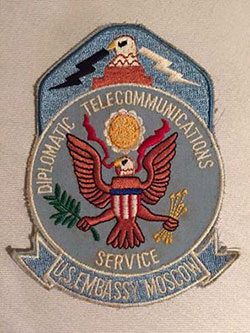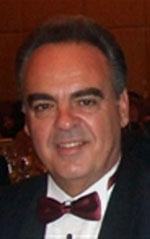Communications Behind the Iron Curtain
This firsthand account of a fire in the secure area of Embassy Moscow on March 28, 1991, conveys the importance and drama of Diplomatic Telecommunications Service work during the last days of the USSR.
BY TIMOTHY C. LAWSON

March 28, 1991. Moscow’s gray Stalinist-style buildings—adorned with red, hammer–and-sickle-emblazoned flags waving in the wind—loomed against a metallic sky. The sidewalk from the new embassy compound up to the old embassy, where I worked, was slippery with dirty, melting snow. A small church, nicknamed “Our Lady of Eternal Surveillance” or, later, “Our Lady of Perpetual Observation” because it doubled as a KGB listening post, sat directly across the street. The morning was normal but for one thing: tension hung in the air like icicles, a tension felt not only by our embassy reporting officers, but by millions of Soviet citizens.
Supporters of Boris Yeltsin, then president of the Russian Federation, planned to stage a demonstration that day. Even after the fall of the Berlin Wall, demonstrations inside the USSR were rare. This one, if held, would directly defy Soviet President Mikhail Gorbachev. The yoke of control was still tight, with the Kremlin remaining our number-one national security threat, but fissures in the heart of communism were forming. You could see it on Arbat Street, teeming with subversive artists and cafes and where, after dusk, Order of Lenin medals could be had for a handful of rubles. Change was coming.
Just after 10 in the morning, a fire alarm in the embassy blared. With ongoing construction in the chancery it frequently activated for no reason. Such were working conditions inside our dilapidated embassy, one the United States had occupied since 1953. Unconcerned, I went to reset the alarm (our normal response) and to get another cup of coffee; unbeknownst to me, a thick plume of white and yellow smoke was rising from below. Like a great billowing ghost racing up the stairwell, it approached my office, gateway to the most secure area of any U.S. embassy: the Communications Programs Unit (known as the CPU).
Even without a Top Secret security clearance, safe combinations or “Cryptographic For Use” access, the approaching fire would prove unstoppable.
Back to the Future
Only a year earlier, another staffer had called out to me from across our secure communications vault, “Tim, come look at this!” It was a secret, captioned cable approved by Ambassador Jack Matlock for immediate transmission to Washington (e.g., the White House, State Department, CIA and Joint Chiefs of Staff). 90 Moscow 23603’s ominous subject line: “LOOKING INTO THE ABYSS: THE POSSIBLE COLLAPSE OF THE SOVIET UNION AND WHAT WE SHOULD BE DOING ABOUT IT.”
The cable was clearly the most sensitive I’d ever seen. Because of that sensitivity, Ambassador Jack Matlock and drafting officer Ray Smith (see his article, p. 21) requested that special handling and encoding safeguards be applied. Known as “double encryption” (a process unique to the Foreign Service and the DTS), this involved one-time encoding augmented by “bulk encryption,” achieving a level of protection good enough to stop even today’s hackers dead in their tracks. The predictions laid out in the cable would, barely a year later, prove prophetic.
Moscow’s CPU was responsible for secret communications involving history-making strategy—seven days a week, 24 hours a day.
Looking back, there is no question that 90 Moscow 23603 (declassified in 2007) and other cogent reporting cables proved the predictive powers of the Foreign Service. These cables showcased the substantive intellectual skills, understanding and influence that quietly drew political insights about the realities both inside and outside the Soviet politburo. The “last three feet” of one-on-one diplomacy led to astute on-the-ground analysis that even today serves as a benchmark for successful reporting.
As Ambassador Matlock later wrote: “Embassy Moscow and its associated posts covered political and economic developments in the Soviet Union during the years leading up to and through the breakup without the assistance of a single clandestine source. By 1987, every ‘human intelligence’ source in the Soviet Union had been exposed to the KGB, not through lack of security at the Embassy Moscow, as many in Washington once suspected, but—as we learned years later—by moles in the CIA (Aldrich Ames) and the FBI (Robert Hanssen). The most serious security lapses by far occurred in Washington, not in Moscow” (see “Embassy Moscow: On the Front Lines of History” in the December 2011 FSJ).
Equally important was the support provided by our management section and in particular, by the team I led: the CPU. Moscow’s CPU was responsible for secret communications involving history-making strategy. Seven days a week, 24 hours a day, we managed the department’s largest TEMPEST personal computer program for classified processing and provided emergency radio, telephone and pouch services. Unlike other CPU operations, we served as the embassy’s official liaison to the Soviet Foreign Ministry for Direct Communication Link (i.e., “hotline”) issues and for a separate, fledgling Nuclear Risk Reduction Center initiative.
A Moscow assignment meant earning your pay and then some. As a 32-year-old FS-4 encumbering an FS-1 information management officer position in charge of it all, I would, indeed, earn my pay.
Preventing Nuclear War
In support of President George H.W. Bush’s “confidence-building measures,” CPU coordinated logistical arrangements for DCL and NRRC negotiations. The negotiations produced important agreements, some still in force today. While the hotline could be used for any global crisis, the NRRC was specifically designed to reduce the risk of accidental nuclear war between the United States and the USSR. Article 2 of the NRRC protocol tasked my staff with a special duty: It called upon each party, through its embassy, to provide cryptographic keying material to operate the NRRC securely. This would lead to one of the most bizarre experiences of my career. Hand-delivering a top secret cryptographic key to Soviet personnel was something I had seen in James Bond and other spy thrillers, but never imagined doing myself. Yet those were our instructions.
Still—remembering my former U.S. military training and the “Evil Empire” mantra from my first Moscow assignment (1983-1985), as well as the “Year of the Spy” only five years prior—the communist bogey-man haunted us. Microwave beams aimed at CPU and my living quarters, “spy dust” on my car’s steering wheel and KGB-bugged embassy typewriters made the NRRC crypto protocol feel traitorous, until we were assured by the highest levels that it was to prevent nuclear war.
And so in late 1989 I found myself accompanying a senior NRRC delegate from the White House on a special mission. Down iron stairways, through echoing corridors of reinforced concrete and manned by armed Soviet soldiers, we made our way deep inside an underground Soviet nuclear command bunker. In my hand was an NRRC protocol document from the U.S. president. As a Soviet general and two staff aides approached, I knew this was more than routine diplomacy. It was a once-in-a-lifetime national security task, with implications for the entire planet.
VIP Visits and “Oval Office-Style” Tutoring

From 1989 to 1991, the embassy hosted high-level visits from virtually every Cabinet agency of the U.S. government, with Secretary of State James Baker visiting Moscow almost monthly. One of the most unusual and demanding visits was that of Pres. Bush’s chief of staff, John Sununu.
Following the Soviet Parliament’s election of Gorbachev to the newly created position of President of the Soviet Union (in addition to General Secretary of the Communist Party), Gorbachev expressed interest in creating an American- style “Oval Office.” Pres. Bush dispatched Sununu to assist. Although reports varied on the effectiveness of Sununu’s Kremlin tutoring, the five-day visit required close coordination with the White House.
I can recall the expression of shock by our resident secure telephone officer (communications electronic officer–telephone, CEO/T) when Washington advised that Sununu would need private and continuous telephone connectivity to the White House—directly from Red Square. Saying no was not an option. While the arcane technical solution employed to achieve this feat cannot be explained here, our CEO/T heroically made the impossible possible.
As U.S. media later reported: “Sununu was in touch with the White House at all times, and could have gotten through to the president on his cigarette boat off the Maine coast from anywhere inside the Kremlin.” Not reported was the magic of CEO/T Charlie Hall, who made it possible.
Tension, Smoke and Fear
It was now approximately 10:25 on that March morning in 1991. As the fire raged below, everyone had evacuated the building except for me and one other communicator, Donna Chick-Bowers. Donna and I needed to ensure that the CPU was secure, that Washington was notified, and that combinations and emergency crypto keys were gathered before we could evacuate. Once finished, we opened the electronic doors to my outside office and were immediately engulfed in billowing smoke, unable to see, barely able to breathe.
What had been tension now changed to outright fear. I thought back to the recent death of a communications colleague, on temporary duty (TDY) from Embassy Helsinki to Leningrad, who perished because of heavy smoke caused by fire. In that tragedy, smoke overcame Support Communications Officer Pasqual Martinez in his hotel room. Pasqual’s remains were only identified via dental records. He had volunteered for the TDY to Leningrad at my request.
Donna and I struggled to find the exit. In the hallway we were blinded by smoke. Clinging to the metal railing along the stairwell, coughing, trying to take in only tiny gasps of smoky air, we descended several flights to what was supposed to be an emergency exit. But when I pushed the exit open, a towering burst of flames roared at us from the source of the fire itself. We had no choice but to climb back up two flights of stairs to the front entrance of the embassy, now our only escape route. We were the last two employees to evacuate, but we had survived.
Members of my team reentered the burning embassy, more than once, to retrieve essential components without which Embassy Moscow would have lost contact with the outside world (this was before internet, email and social media).
Final Communications, Silent Glory
The USSR’s deadline with history was fast approaching, but my staff was about to experience what would be perhaps our finest hour in Moscow. Even as three suspected KGB “firemen” were spotted by our security personnel leaving the building, evading an RSO checkpoint and departing via a strategically positioned taxi around the corner, the CPU and our systems team were already hard at work, restoring vital command-andcontrol circuitry to an alternate embassy site and installing unclassified workstations in the cafeteria.
Courageously, members of my team reentered the burning embassy, more than once, to retrieve essential components without which Embassy Moscow would have lost contact with the outside world (this was before internet, email and social media). CEOs Bart and Hall combined cryptographic and telephony skills to restore secure-voice capability, enabling the ambassador to contact Washington. In what was arguably the most important post in the world, only hours after a major fire, America’s eyes and ears were once again functioning. It was a proud moment to be in the Foreign Service and a member of the DTS. This was, after all, America’s first line of defense: U.S. Embassy Moscow.
Despite the challenges we faced inside a rapidly crumbling USSR, Washington expected a world-class performance. Our achievements inside a Soviet Union that no longer exists won us a Superior Honor Award nomination, but not the prize itself. Diplomatic Security would not authorize the award, citing “security reasons.”
The words of George F. Kennan, former ambassador to the USSR, were relevant to my Moscow staff on that day in 1991: “It takes a special love of country to pursue, with love, faith and cheerfulness, work for which no parades will ever march, no crowds will ever cheer and no bands will ever play.” I dedicate this article to all former, present and future Embassy Moscow employees, with a special salute to all information resource management specialists.








